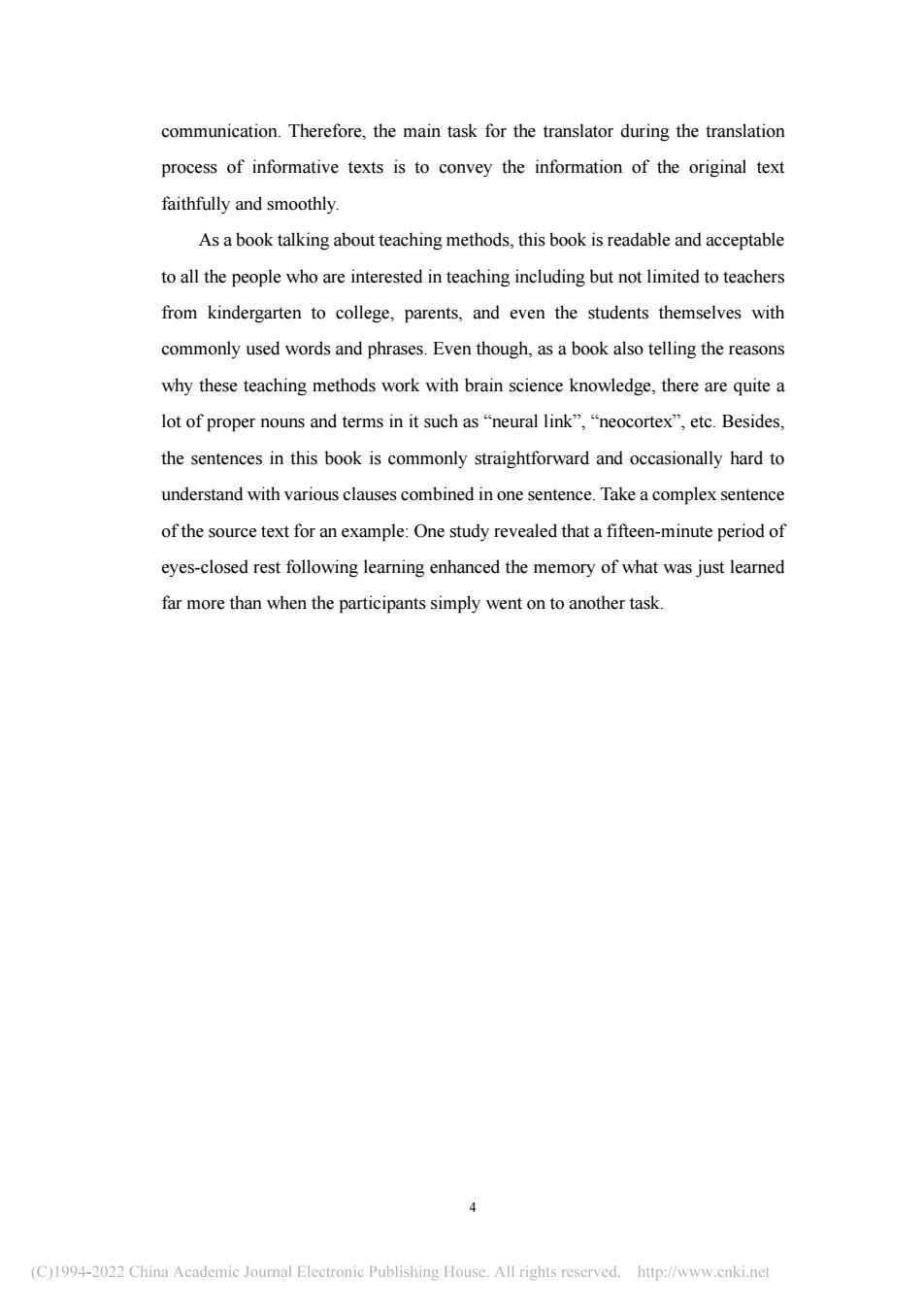
communication.Therefore,the main task for the translator during the translation process of informative texts is to convey the information of the original text faithfully and smoothly As a book talking about teaching methods,this book is readable and acceptable to all the people who are interested in teaching including but not limited to teachers from kindergarten to college.parents,and even the students themselves with commonly used words and phrases.Even though,as a book also telling the reasons why these teaching methods work with brain science knowledge,there are quite a lot of proper nouns and terms in it such as"neural link","neocortex",etc.Besides. the sentences in this book is commonly straightforward and occasionally hard to understand with various clauses combined in one sentence.Take a complex sentence of the source text for an example:One study revealed that a fifteen-minute period of eyes-closed rest following learning enhanced the memory of what was just learned far more than when the participants simply went on to another task. (C)1994-022 China Academie Joumal Elecronic Publishing House.All rights reserved.http://www.enki.net
4 communication. Therefore, the main task for the translator during the translation process of informative texts is to convey the information of the original text faithfully and smoothly. As a book talking about teaching methods, this book is readable and acceptable to all the people who are interested in teaching including but not limited to teachers from kindergarten to college, parents, and even the students themselves with commonly used words and phrases. Even though, as a book also telling the reasons why these teaching methods work with brain science knowledge, there are quite a lot of proper nouns and terms in it such as “neural link”, “neocortex”, etc. Besides, the sentences in this book is commonly straightforward and occasionally hard to understand with various clauses combined in one sentence. Take a complex sentence of the source text for an example: One study revealed that a fifteen-minute period of eyes-closed rest following learning enhanced the memory of what was just learned far more than when the participants simply went on to another task
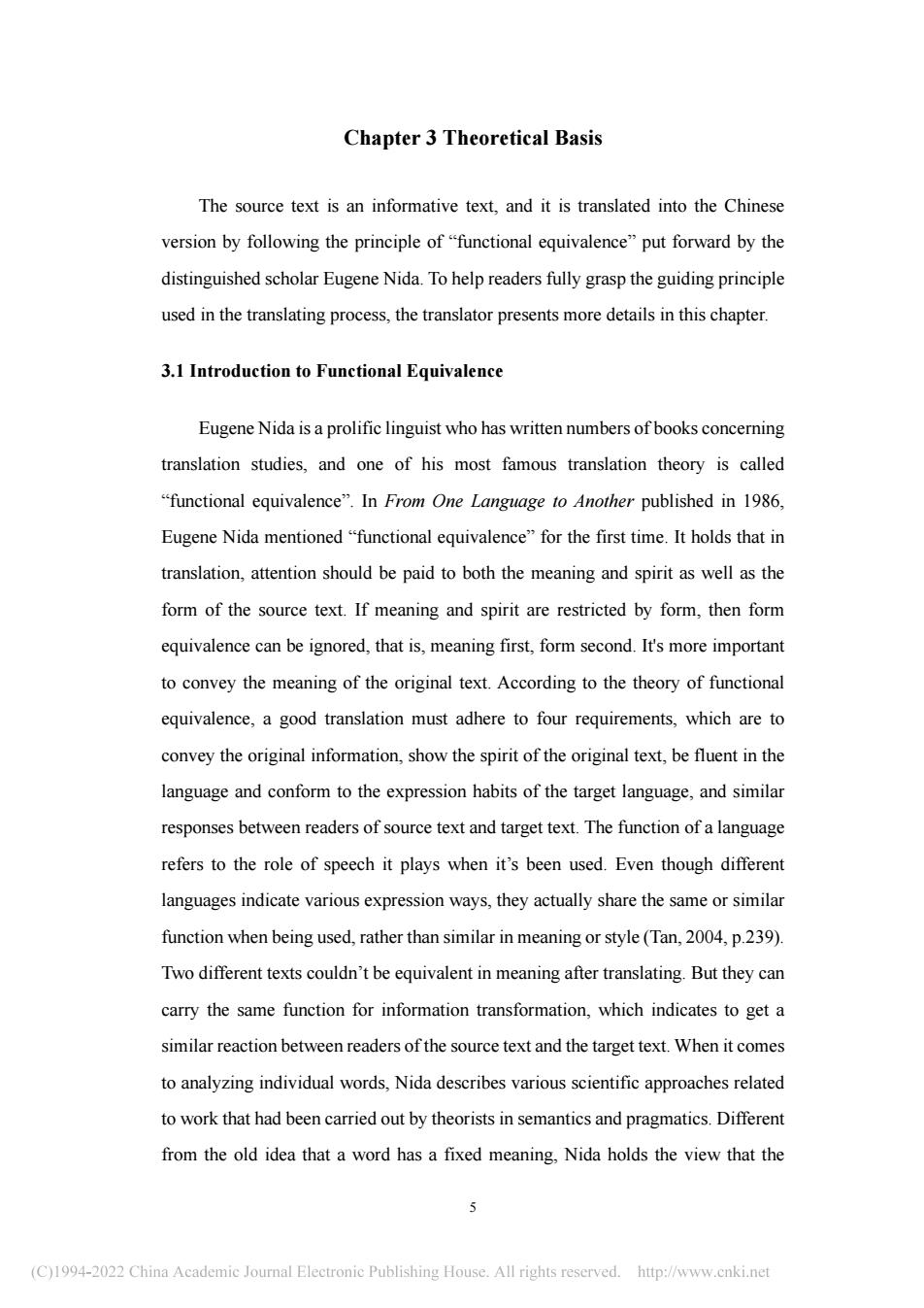
Chapter 3 Theoretical Basis The source text is an informative text,and it is translated into the Chinese version by following the principle of"functional equivalence"put forward by the distinguished scholar Eugene Nida.To help readers fully grasp the guiding principle used in the translating process,the translator presents more details in this chapter. 3.1 Introduction to Functional Equivalence Eugene Nida is a prolific linguist who has written numbers of books concerning translation studies,and one of his most famous translation theory is called "functional equivalence".In From One Language to Another published in 1986. Eugene Nida mentioned"functional equivalence"for the first time.It holds that in translation,attention should be paid to both the meaning and spirit as well as the form of the source text.If meaning and spirit are restricted by form,then form equivalence can be ignored,that is,meaning first,form second.It's more important to convey the meaning of the original text.According to the theory of functional equivalence,a good translation must adhere to four requirements,which are to convey the original information,show the spirit of the original text,be fluent in the language and conform to the expression habits of the target language,and similar responses between readers of source text and target text.The function of a language refers to the role of speech it plays when it's been used.Even though different languages indicate various expression ways,they actually share the same or similar function when being used,rather than similar in meaning or style(Tan,2004,p.239) Two different texts couldn't be equivalent in meaning after translating.But they can carry the same function for information transformation,which indicates to get a similar reaction between readers ofthe source text and the target text.When it comes to analyzing individual words,Nida describes various scientific approaches related to work that had been carried out by theorists in semantics and pragmatics.Different from the old idea that a word has a fixed meaning,Nida holds the view that the 5 (C)1994-2022 China Academie Joural Electronie Publishing House.All rights reserved.http://www.enki.net
5 Chapter 3 Theoretical Basis The source text is an informative text, and it is translated into the Chinese version by following the principle of “functional equivalence” put forward by the distinguished scholar Eugene Nida. To help readers fully grasp the guiding principle used in the translating process, the translator presents more details in this chapter. 3.1 Introduction to Functional Equivalence Eugene Nida is a prolific linguist who has written numbers of books concerning translation studies, and one of his most famous translation theory is called “functional equivalence”. In From One Language to Another published in 1986, Eugene Nida mentioned “functional equivalence” for the first time. It holds that in translation, attention should be paid to both the meaning and spirit as well as the form of the source text. If meaning and spirit are restricted by form, then form equivalence can be ignored, that is, meaning first, form second. It's more important to convey the meaning of the original text. According to the theory of functional equivalence, a good translation must adhere to four requirements, which are to convey the original information, show the spirit of the original text, be fluent in the language and conform to the expression habits of the target language, and similar responses between readers of source text and target text. The function of a language refers to the role of speech it plays when it’s been used. Even though different languages indicate various expression ways, they actually share the same or similar function when being used, rather than similar in meaning or style (Tan, 2004, p.239). Two different texts couldn’t be equivalent in meaning after translating. But they can carry the same function for information transformation, which indicates to get a similar reaction between readers of the source text and the target text. When it comes to analyzing individual words, Nida describes various scientific approaches related to work that had been carried out by theorists in semantics and pragmatics. Different from the old idea that a word has a fixed meaning, Nida holds the view that the
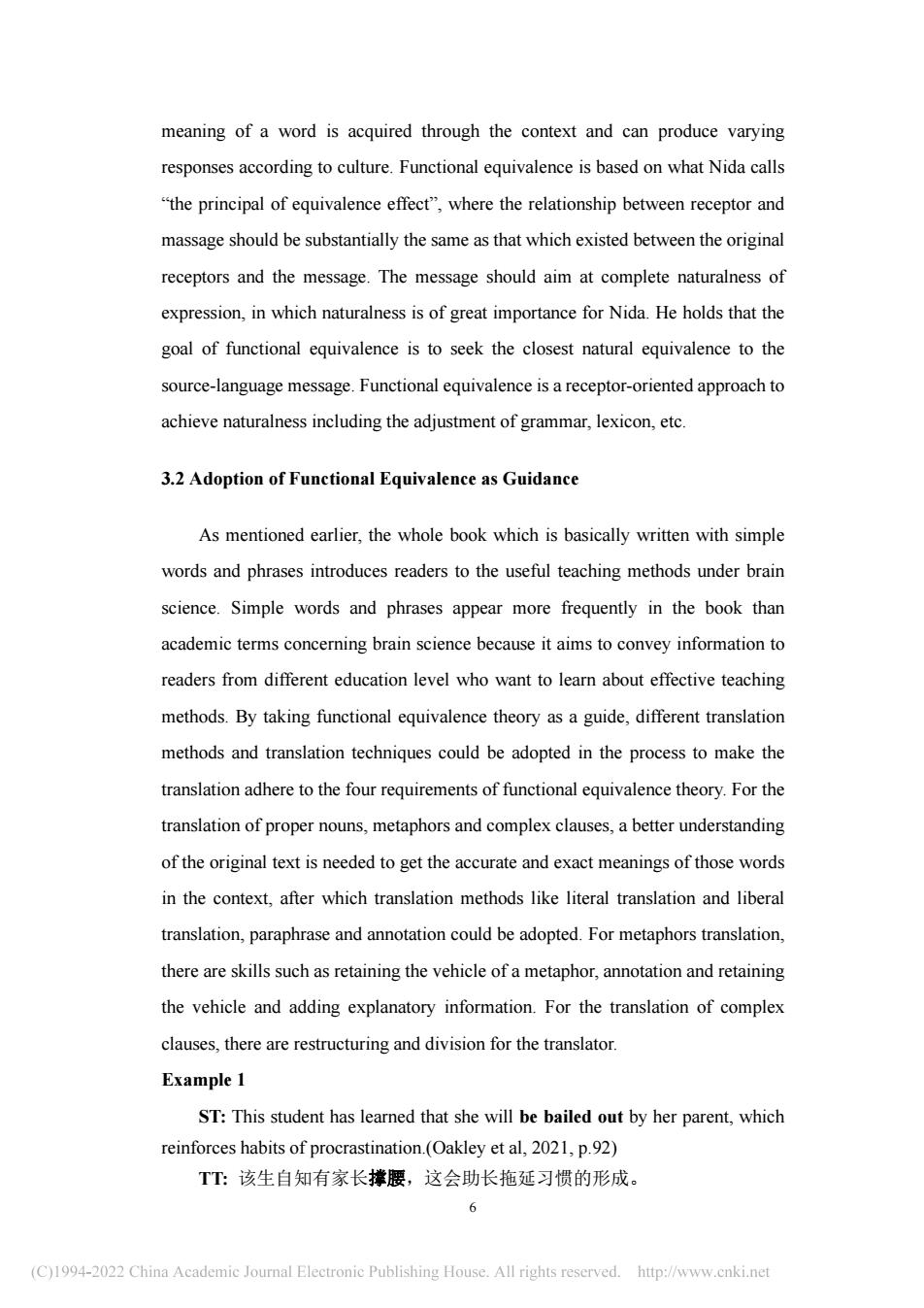
meaning of a word is acquired through the context and can produce varying responses according to culture.Functional equivalence is based on what Nida calls the principal of equivalence effect"where the relationship between receptor and massage should be substantially the same as that which existed between the original receptors and the message.The message should aim at complete naturalness of expression,in which naturalness is of great importance for Nida.He holds that the goal of functional equivalence is to seek the closest natural equivalence to the source-language message.Functional equivalence is a receptor-oriented approach to achieve naturalness including the adjustment of grammar,lexicon,etc. 3.2 Adoption of Functional Equivalence as Guidance As mentioned earlier,the whole book which is basically written with simple words and phrases introduces readers to the useful teaching methods under brain science.Simple words and phrases appear more frequently in the book than academic terms concerning brain science because it aims to convey information to readers from different education level who want to learn about effective teaching methods.By taking functional equivalence theory as a guide,different translation methods and translation techniques could be adopted in the process to make the translation adhere to the four requirements of functional equivalence theory.For the translation of proper nouns,metaphors and complex clauses,a better understanding of the original text is needed to get the accurate and exact meanings of those words in the context,after which translation methods like literal translation and liberal translation,paraphrase and annotation could be adopted.For metaphors translation. there are skills such as retaining the vehicle of a metaphor,annotation and retaining the vehicle and adding explanatory information.For the translation of complex clauses,there are restructuring and division for the translator. Example 1 ST:This student has learned that she will be bailed out by her parent,which reinforces habits of procrastination.(Oakley eta,2021,p.92) TT:该生自知有家长撑腰,这会助长拖延习惯的形成, 6 (C)1994-2022 China Academie Joumal Electronie Publishing House.All rights reserved.http://www.enki.net
6 meaning of a word is acquired through the context and can produce varying responses according to culture. Functional equivalence is based on what Nida calls “the principal of equivalence effect”, where the relationship between receptor and massage should be substantially the same as that which existed between the original receptors and the message. The message should aim at complete naturalness of expression, in which naturalness is of great importance for Nida. He holds that the goal of functional equivalence is to seek the closest natural equivalence to the source-language message. Functional equivalence is a receptor-oriented approach to achieve naturalness including the adjustment of grammar, lexicon, etc. 3.2 Adoption of Functional Equivalence as Guidance As mentioned earlier, the whole book which is basically written with simple words and phrases introduces readers to the useful teaching methods under brain science. Simple words and phrases appear more frequently in the book than academic terms concerning brain science because it aims to convey information to readers from different education level who want to learn about effective teaching methods. By taking functional equivalence theory as a guide, different translation methods and translation techniques could be adopted in the process to make the translation adhere to the four requirements of functional equivalence theory. For the translation of proper nouns, metaphors and complex clauses, a better understanding of the original text is needed to get the accurate and exact meanings of those words in the context, after which translation methods like literal translation and liberal translation, paraphrase and annotation could be adopted. For metaphors translation, there are skills such as retaining the vehicle of a metaphor, annotation and retaining the vehicle and adding explanatory information. For the translation of complex clauses, there are restructuring and division for the translator. Example 1 ST: This student has learned that she will be bailed out by her parent, which reinforces habits of procrastination.(Oakley et al, 2021, p.92) TT: 该生自知有家长撑腰,这会助长拖延习惯的形成
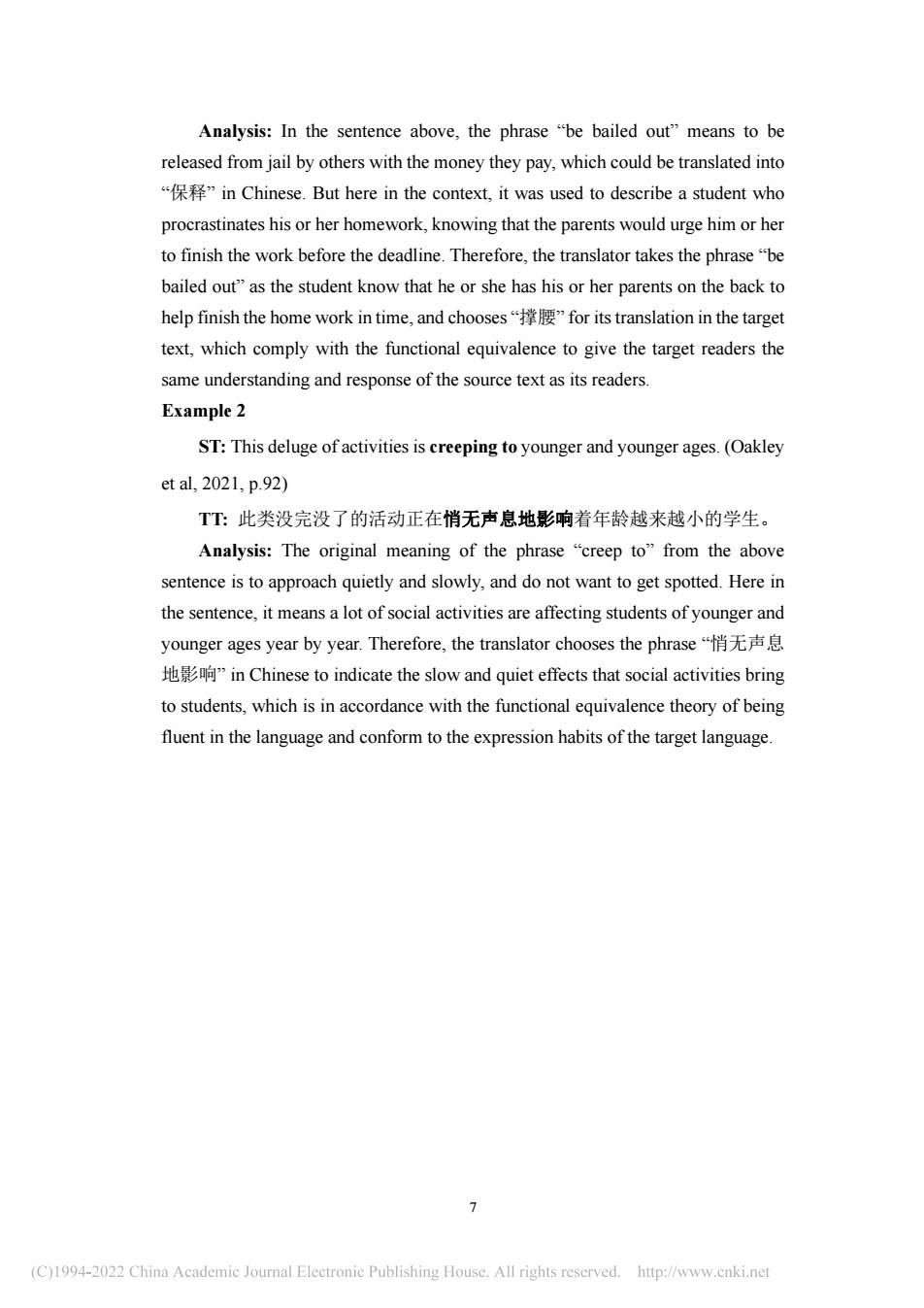
Analysis:In the sentence above,the phrase "be bailed out"means to be released from jail by others with the money they pay,which could be translated into "in Chinese.But here in the context,it was used to describe a student who procrastinates his or her homework,knowing that the parents would urge him or her to finish the work before the deadline.Therefore,the translator takes the phrase"be bailed out"as the student know that he or she has his or her parents on the back to help finish the home work in time,.and chooses“撑腰”for its translation in the target text,which comply with the functional equivalence to give the target readers the same understanding and response of the source text as its readers. Example 2 ST:This deluge of activities is creeping to younger and younger ages.(Oakley etal,202l,p.92) TT:此类没完没了的活动正在悄无声息地影响着年龄越来越小的学生。 Analysis:The original meaning of the phrase "creep to"from the above sentence is to approach quietly and slowly.and do not want to get spotted.Here in the sentence,it means a lot of social activities are affecting students of younger and younger ages year by year.Therefore,the translator chooses the phrase“悄无声息 in Chinese to indicate the slow and quiet effects that social activities bring to students,which is in accordance with the functional equivalence theory of being fluent in the language and conform to the expression habits of the target language 7 (C)1994-2022 China Academie Joumal Electronie Publishing House.All rights reserved.http://www.enki.net
7 Analysis: In the sentence above, the phrase “be bailed out” means to be released from jail by others with the money they pay, which could be translated into “保释” in Chinese. But here in the context, it was used to describe a student who procrastinates his or her homework, knowing that the parents would urge him or her to finish the work before the deadline. Therefore, the translator takes the phrase “be bailed out” as the student know that he or she has his or her parents on the back to help finish the home work in time, and chooses “撑腰” for its translation in the target text, which comply with the functional equivalence to give the target readers the same understanding and response of the source text as its readers. Example 2 ST: This deluge of activities is creeping to younger and younger ages. (Oakley et al, 2021, p.92) TT: 此类没完没了的活动正在悄无声息地影响着年龄越来越小的学生。 Analysis: The original meaning of the phrase “creep to” from the above sentence is to approach quietly and slowly, and do not want to get spotted. Here in the sentence, it means a lot of social activities are affecting students of younger and younger ages year by year. Therefore, the translator chooses the phrase “悄无声息 地影响” in Chinese to indicate the slow and quiet effects that social activities bring to students, which is in accordance with the functional equivalence theory of being fluent in the language and conform to the expression habits of the target language
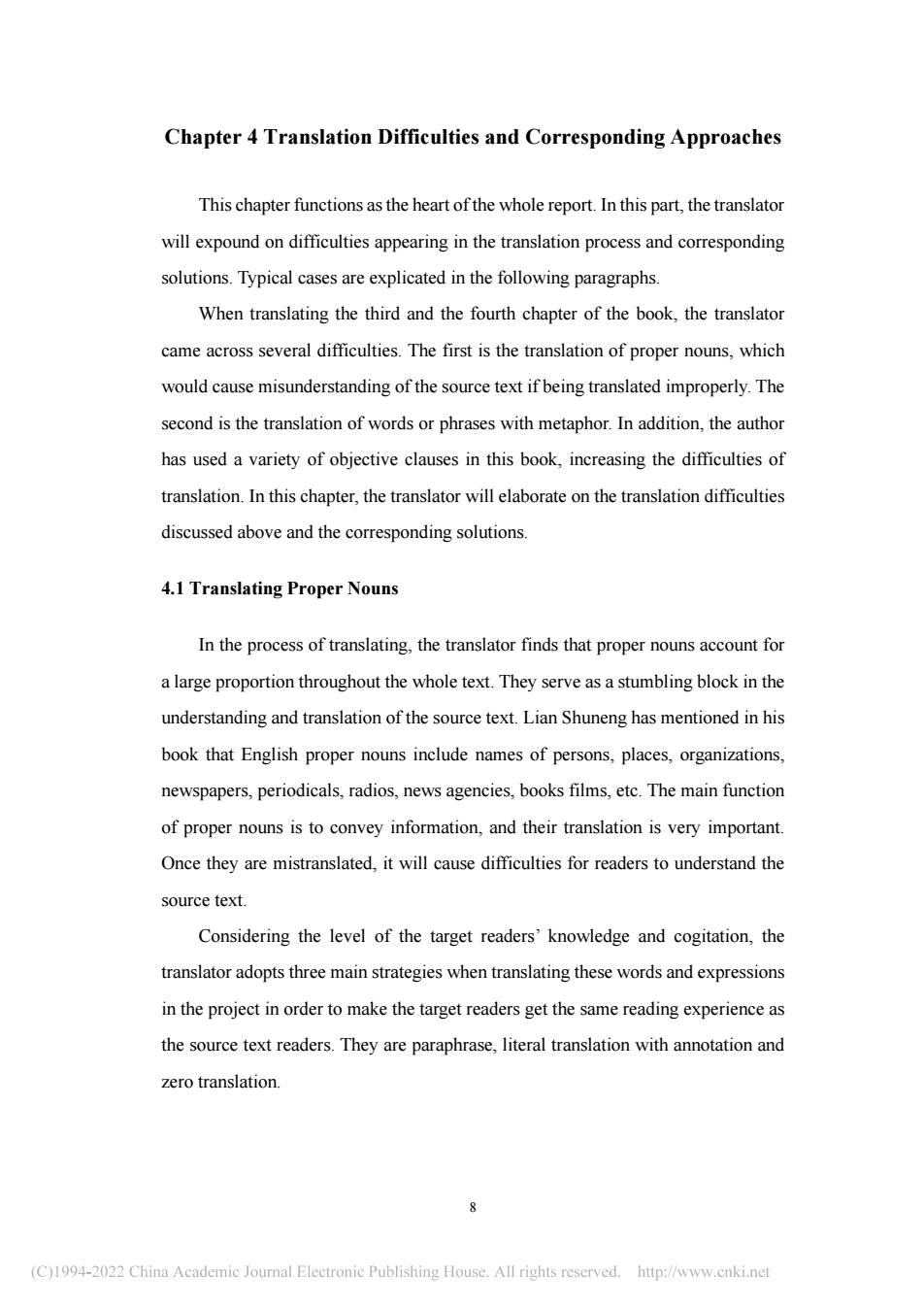
Chapter 4 Translation Difficulties and Corresponding Approaches This chapter functions as the heart of the whole report.In this part,the translator will expound on difficulties appearing in the translation process and corresponding solutions.Typical cases are explicated in the following paragraphs. When translating the third and the fourth chapter of the book,the translator came across several difficulties.The first is the translation of proper nouns,which would cause misunderstanding of the source text if being translated improperly.The second is the translation of words or phrases with metaphor.In addition,the author has used a variety of objective clauses in this book,increasing the difficulties of translation.In this chapter,the translator will elaborate on the translation difficulties discussed above and the corresponding solutions. 4.1 Translating Proper Nouns In the process of translating,the translator finds that proper nouns account for a large proportion throughout the whole text.They serve as a stumbling block in the understanding and translation of the source text.Lian Shuneng has mentioned in his book that English proper nouns include names of persons,places,organizations. newspapers,periodicals,radios,news agencies,books films,etc.The main function of proper nouns is to convey information,and their translation is very important Once they are mistranslated,it will cause difficulties for readers to understand the source text. Considering the level of the target readers'knowledge and cogitation,the translator adopts three main strategies when translating these words and expressions in the project in order to make the target readers get the same reading experience as the source text readers.They are paraphrase,literal translation with annotation and zero translation (C)1994-202 China Academie Joumal Electronie Publishing House.All rights reserved.http://www.enki.net
8 Chapter 4 Translation Difficulties and Corresponding Approaches This chapter functions as the heart of the whole report. In this part, the translator will expound on difficulties appearing in the translation process and corresponding solutions. Typical cases are explicated in the following paragraphs. When translating the third and the fourth chapter of the book, the translator came across several difficulties. The first is the translation of proper nouns, which would cause misunderstanding of the source text if being translated improperly. The second is the translation of words or phrases with metaphor. In addition, the author has used a variety of objective clauses in this book, increasing the difficulties of translation. In this chapter, the translator will elaborate on the translation difficulties discussed above and the corresponding solutions. 4.1 Translating Proper Nouns In the process of translating, the translator finds that proper nouns account for a large proportion throughout the whole text. They serve as a stumbling block in the understanding and translation of the source text. Lian Shuneng has mentioned in his book that English proper nouns include names of persons, places, organizations, newspapers, periodicals, radios, news agencies, books films, etc. The main function of proper nouns is to convey information, and their translation is very important. Once they are mistranslated, it will cause difficulties for readers to understand the source text. Considering the level of the target readers’ knowledge and cogitation, the translator adopts three main strategies when translating these words and expressions in the project in order to make the target readers get the same reading experience as the source text readers. They are paraphrase, literal translation with annotation and zero translation